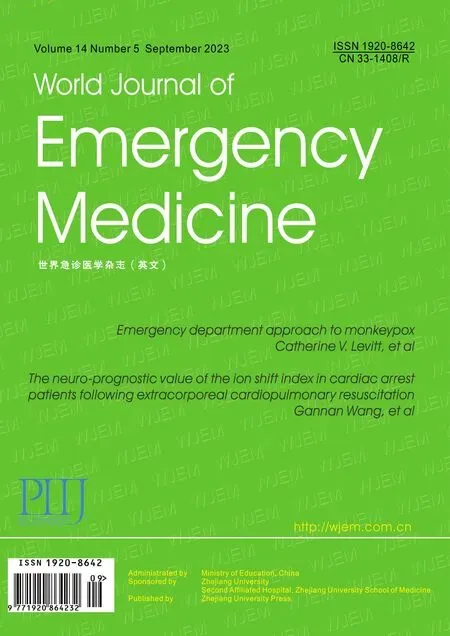Acute hemolytic anemia in a 34-year-old man after inhalation of a volatile nitrite “popper” product
Xiang Peng ,Liuyang Cheng ,Huanhuan Gong ,Jie Wang ,Xiaowei Ke ,Xiangmin Li,2
1 Department of Emergency Medicine, Xiangya Hospital, Central South University, Changsha 410008, China
2 National Clinical Research Center for Geriatric Disorders (Xiangya Hospital), Changsha 410008, China
Inhaled nitrites have been used recreationally for centuries,particularly among men who have sex with men (MSM).[1]After inhalation,this substance quickly enters the blood;within seconds,it can produce a temporary sense of warmth and pleasure,and relax the anal sphincter to relieve the pain of anal sex.[2,3]“Popper” and “rush” are slang terms given to drugs of the chemical class called amyl nitrite or isobutyl nitrite.Nitrites oxidize hemoglobin to methemoglobins and may increase proteolytic susceptibility of hemoglobin,leading to oxidative hemolysis.Thus,their use is associated with methemoglobinemia and hemolytic anemia,[4]although nitrite-induced hemolytic anemia has been described only in rare cases (supplementary Table 1).[4-9]Herein,we report a case of acute hemolytic anemia associated with the use of amyl nitrite.
CASE
A 34-year-old man presented to the emergency department with a 4-day history of jaundice and orange urine.Two days before admission,he was seen by his physician for these symptoms;tests showed a hematocrit of 0.24 (normal range 0.40-0.50),hemoglobin level of 76 g/L (normal range 130-175 g/L),total bilirubin level of 147 μmol/L (normal range 0.0-25.0 μmol/L) and indirect bilirubin of 128.8 μmol/L.He reported no family history of anemia,history of blood transfusions,exposure to ill or unusual animals,ingestion of unusual foods (such as fava beans),or recent exotic travel.
On admission,the physical examination revealed that his blood pressure was 147/87 mmHg (1 mmHg=0.133 kPa),pulse 135 beats/min,respiratory rate 20 breaths/min,and body temperature 36.2 °C.Jaundice of the skin and sclera,anemic appearance,pale conjunctiva and nail beds,and hepatosplenomegaly were also observed.A full blood examination showed a white blood cell count of 16.1×109/L (normal range [3.5-9.5]×l09/L),with a differential cell count of 74% polymorphonuclear leukocytes,17% lymphocytes,7% monocytes,and 2%eosinophils;hemoglobin level of 97 g/L;platelet count of 357×109/L (normal range [125-350]×l09/L);reticulocyte count of 329.1×109/L (normal range [24-84]×l09/L);and reticulocyte percentage of 10.42% (normal range 0.5%-1.5%).His urine contained hemoglobin but not hemosiderin or bilirubin.Laboratory analysis revealed the following values: lactate dehydrogenase 680 U/L (normal range 120-250 U/L),total bilirubin 31.9 μmol/L,indirect bilirubin 21.4 μmol/L,and alanine aminotransferase(ALT) 73.8 U/L (normal range 0-40 U/L).All results were consistent with nonimmune intravascular hemolysis.
After admission,the patient’s serum electrolytes reached critical values: calcium 0.30 mmol/L (normal range 2.11-2.52 mmol/L) and potassium 9.89 mmol/L (normal range 3.50-5.30 mmol/L).Emergency hemodialysis was considered to treat the hyperkalemia;therefore,the patient was transferred to the emergency intensive care unit (EICU),and 1 g calcium gluconate was administered intravenously to antagonize the potassium toxicity.The serum electrolytes were rechecked,and the levels of calcium and potassium were within normal ranges.Upon further inquiry,the patient admitted heavy recreational use of inhaled nitrites,including twice per day five days prior.
Later tests confirmed that he was infected with HIV.The results showed direct and indirect Coombs tests (-),Ham’s test (-),paroxysmal nocturnal hemoglobinuria (PNH)clone detection (-),and dot blot hybridisation (thalassemia)suggested α-thalassemia of Southeast Asian (SEA) deletion.He was treated conservatively with intravenous anti-jaundice and enzyme-lowering f luids,and was discharged 48 h later with no further signs of hemolysis.Further investigation,such as the measurement of glucose-6-phosphate dehydrogenase (G-6-PD),was incomplete because the patient did not attend follow-up appointments.
DISCUSSION
Our patient developed acute hemolytic anemia after inhaling a “popper” product,an amyl nitrite used with the intention of enhancing sexual performance due to their vasodilator effects,anal sphincter relaxation,and aphrodisia.Nitrites,such as amyl nitrite,are highly volatile yellow liquids that rapidly dilate blood vessels when inhaled from a pressurized container.Volatile nitrites have numerous physiological effects,[10]and are well known for their oxidative effects on hemoglobin.[11]Oxidative hemolysis occurs when normal processes are unable to reduce ferric iron,also known as methemoglobin,to ferrous iron,which carries oxygen.[12]Volatile nitrites are associated with significant red cell hemolysis in patients with decreased or normal G-6-PD levels because such nitrites act as cellmembrane oxidants.[6]
Patients with anemia usually do not show obvious symptoms and do not require special treatment.However,acute hemolytic anemia may be induced after taking or inhaling certain oxidizing agents.[13]For oxidative hemolytic anemia,treatment includes supportive care and discontinuation of the agents,both of which were used in this case.Interestingly,our patient developed pseudohyperkalemia and hypocalcemia,and electrolyte levels were completely normal when retested.
Although nitrite-induced hemolytic anemia has only been described in rare cases,a much higher endemic prevalence is expected,considering the widespread use and strong oxidizing activity of nitrite.The underestimation of the incidence rate of nitrite-induced hemolytic anemia probably reflects secret use and low awareness.Currently,there is no restriction on the sale and use of nitrites in China,and many companies sell it as a “fragrance”.High availability,combined with low price,contributes to its widespread use in MSM.
CONCLUSIONS
Hemolytic anemia can be caused by drugs used for recreational purposes.Healthcare workers should be aware that these commonly abused drugs can cause not only life-threatening methemoglobinemia but also significant hemolysis.
Funding:The study was supported by a grant from Natural Science Foundation of Hunan Province (2022JJ30938).
Ethical approval:Ethics approval was waived because this is a retrospective case report on one patient who gave consent for publication.
Conf licts of interests:The authors declare no conf lict of interest.
Contributors:XP and XML made substantial contributions to the concept of the article,data acquisition,and clinical interpretation of data.LYC,HHG,JW,and XWK contributed to the acquisition of data.XP drafted the article and revised it critically for important intellectual content.XML approved the version to be published.All authors have read and approved the manuscript.
All the supplementary files in this paper are available at http://wjem.com.cn.
 World journal of emergency medicine2023年5期
World journal of emergency medicine2023年5期
- World journal of emergency medicine的其它文章
- Severe disseminated intravascular coagulation complicated by acute renal failure during pregnancy
- Establishment and evaluation of animal models of sepsis-associated encephalopathy
- Key elements and checklist of shared decisionmaking conversation on life-sustaining treatment in emergency: a multispecialty study from China
- Acute adrenal insufficiency caused by antiphospholipid syndrome
- Inferior vena cava thrombosis in two adult patients with veno-arterial extracorporeal membrane oxygenation
- A case report of intramyocardial dissecting hematoma: a challenging diagnosis
